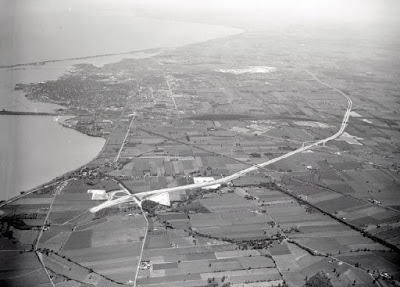In the Sandusky Library Archives Research Center are
two volumes entitled Appraisal of Erie
County Properties at Sandusky, Ohio. The appraisal was done by the Warren
S. Holmes Company of Lansing Michigan, and was dated June 26, 1933. Volume 1 of
the set contains the appraisal of the Erie County Infirmary, including the main
Infirmary building as well as several other structures on the property of the
Erie County Infirmary.

The historic limestone Erie County
building at 2900 South Columbus Avenue served as the Erie County Infirmary from
1886 until 1976, when the residents were transferred to the Erie County Care
Facility at 3916 East Perkins Avenue in Huron Township. It began as the county
“Poor House Farm” in the 1850s, and soon became known as the Erie County
Infirmary. By 1919, it was known as the Erie County Home. The residents of the
Erie County Infirmary or Erie County Home included those who were aged or
indigent. You can read more about the
history of this facility at the Erie County website.
Volume 1 of the
Appraisal is over 200 pages in length, and contains photographs and blueprints
of the buildings included in the Erie County Infirmary in 1933. At that time,
the replacement value of the main building was $123,260.00 (more than $2 million in today's money). Other buildings
included in the appraisal were the hospital, laundry and boiler house, barns,
and outbuildings. There are figures for replacement value as well as for full
insurable value of each line item.
The Appraisal includes thorough descriptions of the buildings and their contents. The exterior walls of the main
Infirmary building (constructed in 1886, with the north wing added later) were made of Sandusky blue limestone. Exterior
trims, window sills, and lintels were made from limestone. Most of the windows
were double hung with weights. The interior walls were plastered on masonry and
wood lath. The mantels in the superintendent’s rooms were onyx, while other
fireplaces had cast iron fronts. The structure was heated by a two-pipe gravity
steam upfeed system, with steam being provided from a central heating plant.
The plumbing system included city water and sewer system. Water closets had oak
seats and tanks. In 1933 the electric wiring had recently been updated. An Auto
Call fire alarm system made in Shelby, Ohio had been installed in 1932 at a
cost of $899.70. A Philco model 90 radio was housed in the Superintendent’s
living room, and was connected to four loudspeakers throughout the facility. On
page 17, a brief summary stated, “This building, while old, is sound and fairly
well maintained.” Detailed listings of
the contents of the Infirmary Building list how many doors, windows, screens
were located throughout the building. The staff kitchen included a gas range,
as well as a combination gas and coal range. There were also several coffee
pots, kettles, pans, tables and elm and bentwood chairs. In the pantry were table service for 18 and
inexpensive silver, as well as several pots and pans. The basement contained
crocks, butter churns, a cooler, refrigerator and a cream separator. In storage
under the porch of the Infirmary was a supply of toilet paper, corn brooms, and
4 boxes of soap, each containing 120 bars of soap.
Details continue to describe the contents of
all the various rooms of the Infirmary, including bedrooms for men and women. A
Victrola console BB100 with records provided entertainment for the ladies who
resided in the Infirmary, in the women’s day room. A Bible was also found in
the day room. In the attic, were extra chairs, dressers, and ten barrels of
Mason fruit jars. Contents of the hospital, and a description of the two
garages, brooder house, chicken house, corn crib, implement storage building,
hog pen, slaughter house, tool shed, cow shed and storage shed are included in
the Appraisal. In 1933, livestock on the farm included seven cows, as well as
chickens and hogs. Page 210 features photographs
of barns on the grounds of the Infirmary:
Below is a portion of a page from the
1905 Sanborn Map, which shows the layout of the Erie County Home around the
time of the Appraisal.

Besides the basic facts of construction and design of the property, what we can infer from this
Appraisal is that while the County provided a place for needy people to reside,
those who were able were expected to farm the land and participate in the day
to day chores around the Infirmary and farm. Most likely the women assisted in
the canning of the vegetables that were grown.
Butter was churned onsite, and cream was separated by either the staff
or residents. Eggs were gathered from
the chickens on the farm, and pork came from the slaughter of hogs housed in
outbuildings. The facility was
constructed of raw materials that were available locally. Entertainment and
news were available in the technology available to Americans in the 1930s.
While it may be boring to some to go page by page through a 1930s era appraisal
document, you can get a good understanding of the technology in use at that
time, and a life style that was extremely labor-intensive. If you would like to
see the Appraisal of
Erie County Properties in 1933,
stop
by the Reference Services desk at the Sandusky Library.

 this blog
this blog



















































